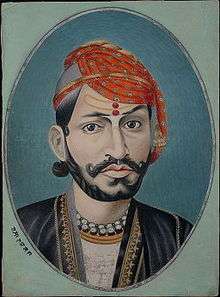Ram Singh II
| Ram Singh II | |
|---|---|
 | |
| Maharaja of Jaipur | |
| Reign | c. 1835 – c. 1880 |
| Born | Jaipur, Jaipur State |
| Father | Jai Singh III |
Ram Singh II was the Maharaja of Jaipur from 1835 until 1880. He was a son of Jai Singh III, Raja of Jaipur. Maharaja Sawai Ram Singh ascended the throne in 1835. He was the 8th Maharaja of Jaipur State. A minor at the time, the administration of the State was conducted by the Minority Council however in lieu of his intelligence, arduous application of State affairs and great grasp of details of State administration he was invested with full powers even before attaining majority.The modernization of Jaipur, under the British influence, was first brought about by Maharaja Sawai Ram Singh II. After Maharaja Sawai Jai Singh II, he is considered as the most enlightened of the Jaipur rulers.
His father, Raja Jai Singh lll was poisoned by Jhuntharam on 6 February 1835.
Called upon to guide the destiny of this State at a very crucial moment in history, when the country stood at the parting of ways. The great Mughal Empire, after running nearly three centuries, was tottering to its fall, while the British statesmen and politicians were engaged in the herculean task of building a new India on the ruins of the old. The East India Company emerged stronger, more stable and had extended its influence throughout the country. A shrewd observer of these new changes and developments, the Maharaja realized the importance and necessity of keeping abreast with the new tendencies and spirit within which this country had begun to pulsate. He therefore took steps to introduce new measures of reform, improvements and developments. Embellishing Jaipur with amenities of modern life and made it not only one of the most picturesque capitals of India but also a progressive and modern State.1860; after establishing peace and tranquility in the State, Maharaja Ram Singh turned his attention towards the improvement of administration and welfare of his people in which he was equally successful. He used to look into the details of every department of State and kept himself fully well informed on what was going on in the different sections of the State administration. His methods of roaming the streets incognito to check on state-officials and the wellbeing of the subjects were very effective.
On works of public utility; he built the Jaipur Water Works (1875), Gas Works (1878), the Mayo Hospital, the Ramniwas Gardens with the Museum, School of Arts, Public Library, Ramprakash Theater, Maharaja’s College (1844), Sanskrit School (1865), the Noble’s School (1862), the Girls School (1867. The Public Works Department was established in 1860. Roads and highways between Jaipur, Ajmer and Agra were constructed during his reign. Besides these dams for irrigation purposes, public buildings, and offices were also built. Raja Ram Singh ll ordered construction of Mayo Hospital outside Sanganeri Gate for public health, Jaipur Water Works, Gas Works & Public Works Department. To provide for drought relief Ram Singh ll constructed Ram Niwas Garden. In those times there were no movies or other recreational facilities. Ram Singh ll built Ram Prakash Theatre in Sirah Dyodhi Bazar.
He was also a reformist and it was in his reign that slavery, child infanticide, and the cruel custom of sati were officially abolished in the State of Jaipur.In the Literary field, Maharaja Ram Singh ji’s major contribution was a lithographic press that added many valuable books to the Pothikhana. He understood the importance of education for boys as well as girls. Sawai Ram Singh ll built Maharaja College for boys, Sanskrit College, Nobles School in Goner, and first ever school for girls in Jaipur. Ram Singh ll constructed School of Arts where students could learn different disciplines of Arts.
The 8th king of Jaipur constructed Rambagh Palace which is now a five star hotel. Rambagh Palace is considered one of the most beautiful Palace hotels of the world.
Photographer Prince of India
Besides being an ardent devotee of Lord Shiva the Maharaja also pursued modern activities such as ballroom dancing, billiards, polo, badminton, kite flying etc. He was the first Photographer Prince of India and the only one to start a formal course in Photography in an institution other than a photography studio. His personal studio or photukhana was filled the latest and best equipments of the time. A member of the Bengal photographic society and hired a Calcutta based English photographer, together, they recorded the building activities in Jaipur, the people, their costumes and culture. His photography work was recently rediscovered after over a century from Madho Niwas wing of City Palace of Jaipur. Sawai Ram Singh ll would click city buildings, people, guests and dancers as subjects. These pictures are a great source of knowledge for those who are interested in history. Ram Singh ll was so much passionate about photography that he invited Mr. T. Murray to help him establish photukhana where he could develop his photographs and learn technical aspects of photography. Raja Ram Singh ll would interact with foreign guests and discussed about new photography techniques and cameras.
Maharaja Ram Singh was the most enlightened and progressive ruler of his time. The British Government recognized his outstanding merits by nominating him twice a Member of the newly formed Viceroy’s Legislative Council, and by adding four guns to his salute. The title of G.C.S.I was also conferred upon him.
Marriage
Sawai Maharaja Sir Ram Singh ll was married to Kumari Chand-Kanwar Bai-Lal, daughter of Maharaja Takhat Singh of Jodhpur and 8 other Maharanis. After sudden illness the 8th king of Jaipur State Sawai Ram Singh ji ll died at a young age of 45 only.
References
- Maharajah Ram Singh II; geni.com
- Jaipur History; JaipurLove